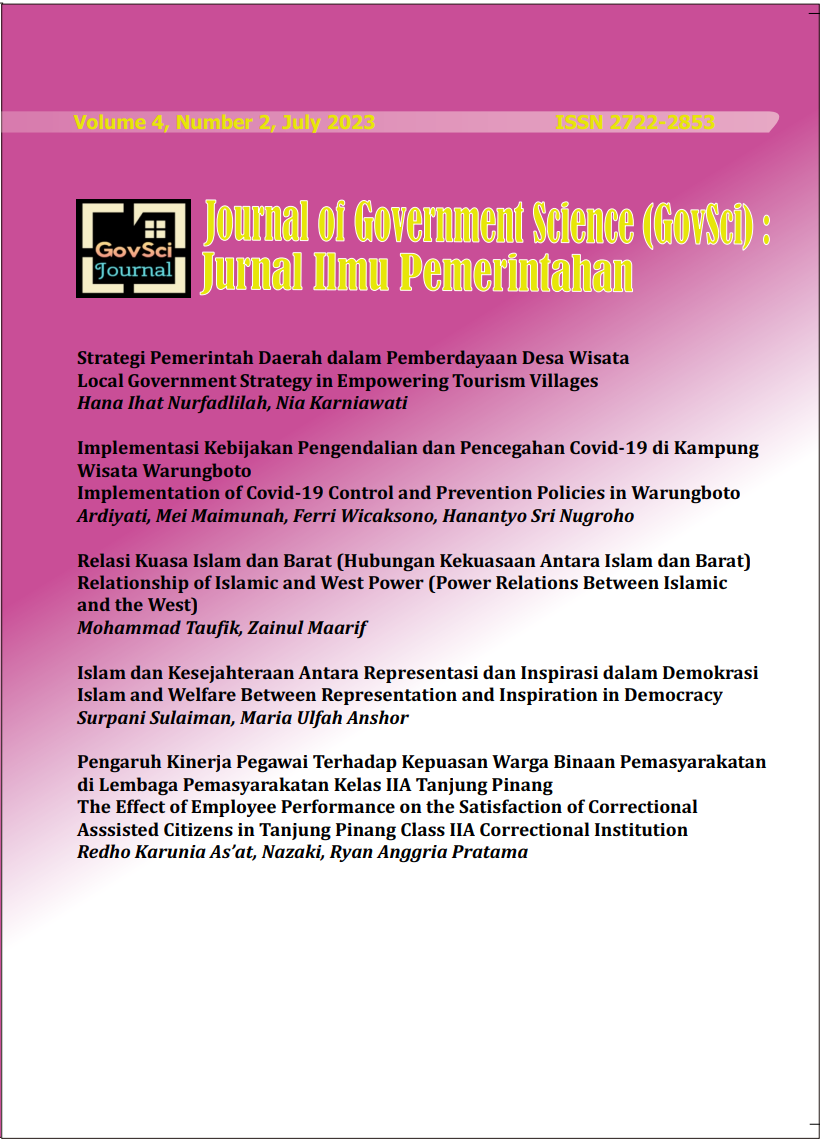Strategi pemerintah daerah dalam pemberdayaan desa wisata Local government strategy in empowering tourism villages
Abstract
A tourism village is a rural area that has a special allure and is able to bring visits to tourists where more specifically a tourist village is bound by strong cultural values and traditional characteristics. When a village has been agreed upon, proclaimed as a "Tourist Village" the village should have the potential to be attractive with the characteristics of a non-urban village. These characteristics will be represented by traditional life and the uniqueness that surrounds it. The purpose of this writing is to find out the strategy of the Regional Government in empowering tourist villages. This is a form of village tourism empowerment carried out by the local government to improve the economy and maintain village wisdom. In this study, researchers used the library study method accompanied by an elaboration analysis of government regulations or policies regarding village tourism. Villages in the world of tourism certainly have their potential, including the natural wealth of the mountains or villages with the wealth of the sea, in terms of culture to history, all of which are present in the body of Bhinneka Tunggal Ika. This research uses a descriptive type with a qualitative approach. According to Moleong, qualitative methods include document observation, or literature search. The results of the study show that in the process of development or tourism village development, the village government is the main party responsible so that the community can be involved, through a regulatory strategy that has been prepared by the village government.
References
Azzaki, Roisul Agam, Nanda Arni Arisanti, Rembulan Ratnasari, and Tyah Safira. 2021. “Policy Paper Peraturan Desa Jarak Fakultas Hukum Universitas 17 Agustus 1945 Surabaya.” (1311800127).
Damanik, Dian, Dian Hotlando Damanik, and Deden Dinar Iskandar. 2019. “Strategi Pengembangan Desa Wisata (Studi Kasus : Desa Wisata Ponggok).” Jurnal Ilmu Ekonomi dan Pembangunan 19(2): 120–27. https://jurnal.uns.ac.id/jiep/article/view/31944.
Harisma, Fitrah Bintan, Fariani Syahrul, Teguh Mubawadi, and Yudied Agung Mirasa. 2018. “Analisis Kejadian Luar Biasa Hepatitis A Di SMA X Kabupaten Lamongan Tahun 2018.” Jurnal Berkala Epidemiologi 6(2): 112–21. https://www.e-
journal.unair.ac.id/JBE/article/view/8433/5367.
Latianingsih, Nining et al. “ISSN : 2775-7374 KABUPATEN BOGOR ISSN : 2775- 7374.” : 54–60.
Lohia, Kecamatan, and Kabupaten Muna. 2018. “MUNA Resti1 1 Alumni Pendidikan Geografi FKIP UHO Kata Kunci : Strategi , Pemerintah Desa , Pengembangan , Pantai Meleura Resti strategy of village government in developing object of coastal tourism meleura in lakarinta village district lohia muna regency.” 3(4): 115–29.
Mahadewi, Ni Putu Eka, and I Putu Sudana. 2017. “Model Strategi Pengembangan Desa Wisata Berbasis Masyarakat.” Jurnal Analisis Pariwisata 17(1): 41–45.
Nugroho, Adi. 2009. “Buku Perancangan.” : 1–140.
Suranny, Lilyk Eka. 2020. “Pengembangan Potensi Desa Wisata Dalam Rangka Peningkatan Ekonomi Perdesaan Di Kabupaten Wonogiri.” Jurnal Litbang Sukowati : Media Penelitian dan Pengembangan 5(1): 49–62.
Syah, Firman. 2017. “Strategi Mengembangkan Desa Wisata.” Prosiding Seminar Nasional Multi Disiplin Ilmu &Call For Papers Unisbank Ke-3 3(Sendi_U 3): 335–41.
Talib, Desrika. 2021. 3 Tulisan Ilmiah Pariwisata (TULIP) Analisis Peran Stakeholder Dalam Pengembangan Destinasi Wisata.
Wisata, Perancangan Desa. 2021. Leran Kulon.
Authors
Copyright (c) 2023 Hana Ihat Nurfadlilah, Nia Karniawati

This work is licensed under a Creative Commons Attribution-ShareAlike 4.0 International License.

